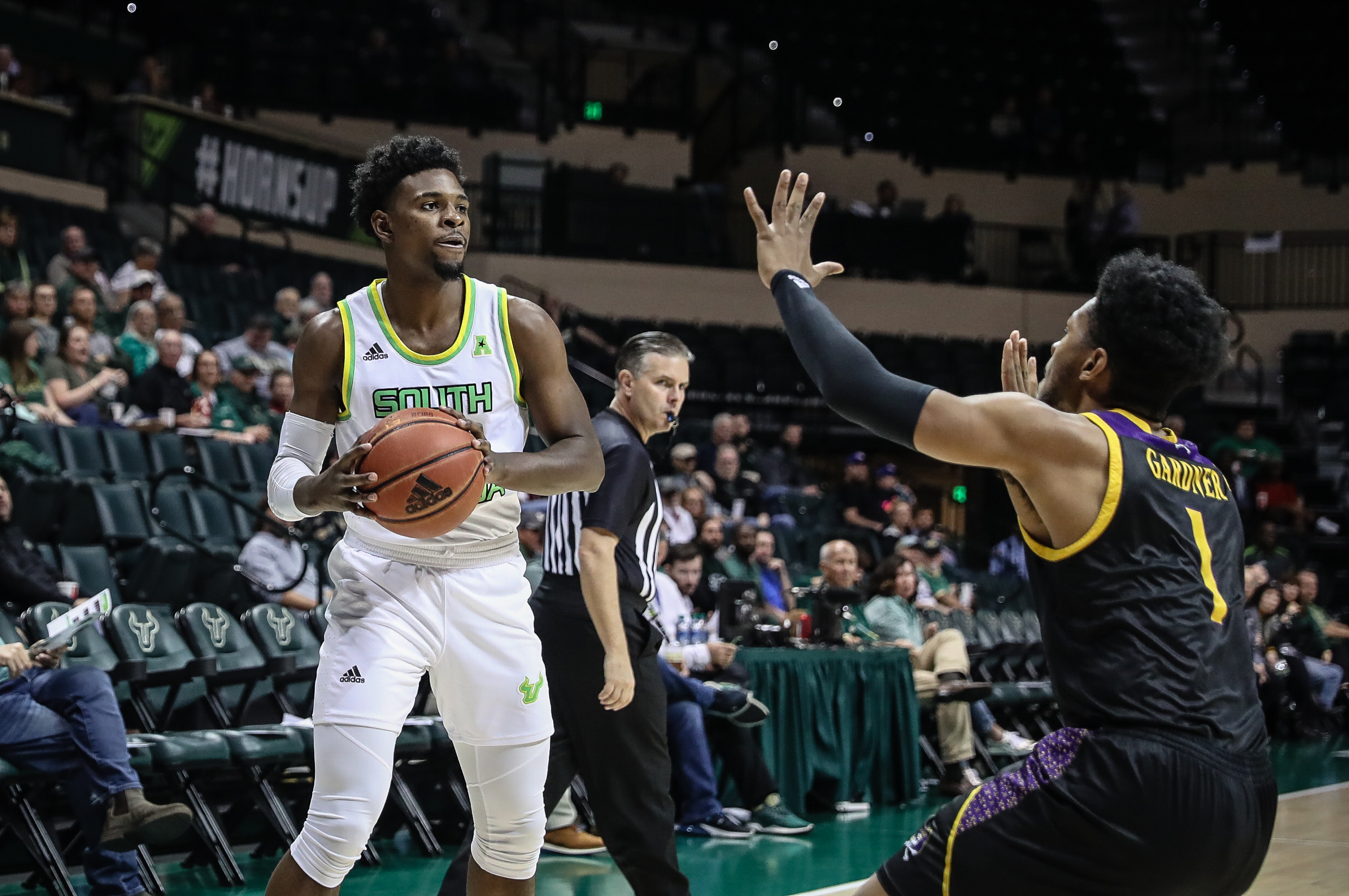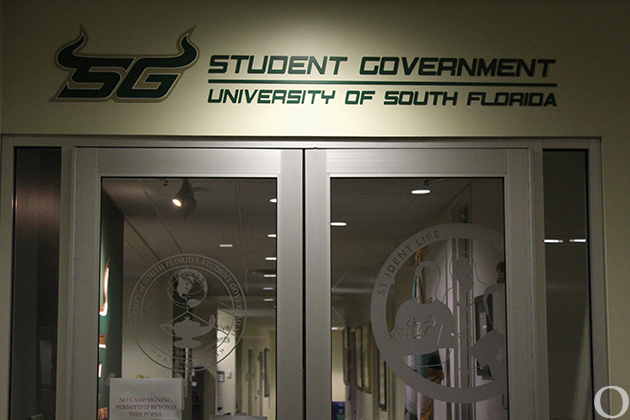MFA Students Take Over CAM
Last Friday marked the opening of one of this semester’s most anticipated exhibitions on campus – the ninth annual Master of Fine Arts graduation exhibition at USF’s Contemporary Art Museum (CAM).
The exhibition, titled “Irreconcilable Differences,” brings a close to a unique museum season for CAM, which celebrated its 20th anniversary earlier this year and is currently showcasing the artworks of eight graduate students in the School of Art and Art History.
The exhibit offers a diverse range of creative styles, woven together through an innate sense of human understanding and wonderment.
The first works viewed upon entrance are the sculpture and photography of Johanna Keefe, who has a total of 11 pieces displayed. As Keefe described in the exhibition’s catalogue, her sculptures focus on the concept of cultural appropriation.
In front of her large print still life photography, one comes upon the unusual scene of her sculpture titled “Menorah,” which is composed of cacti acting as figural candle holders supported by a sculpted Chinese porcelain folding fan. This forms a recognizable symbol of Jewish faith, effectively and humorously bringing forth her intention.
Another sculpture by Emily Elliot, represents male and female human figures. From the front, one is exposed to the anguished posture of the female figure. But a look behind reveals the figures are in the process of detaching from the back, with their joint skin – their last connection – being torn and revealing the male figure’s red, textured flesh.
The figures are rendered so realistically, from their glossy fingernails to their arm hair, that they make a disturbing interaction intimate to the human.
“I was exploring the surface as a canvas for psychological distress,” Elliot said. “There’s something that happens when you make a human slightly animalistic: the viewer is able to other them.”
The works of John Allen, who has a total of eight works displayed, uses pinhole photography to address the relationship of the physical world with that of the internal.
“I enjoy using nature to talk about perception and the complexities of the mind,” Allen said.
Allen explained his pinhole photography series titled “Devil’s Den I-VI” was taken inside caves in Florida. The images, which depict black space with central, misty lighting and only a couple of recognizable elements, such as tree branches and the sky, make it difficult for the viewer to discern what the subject is.
In describing his lighting technique with pinhole photography, Allen said, “It has a sense of not having a scale to it. That’s another way in which I hope to talk about perception.”
As the viewer continues through the exhibition, one cannot ignore the presence of Corbett Fogue – who has five works displayed – especially his large helium Mylar balloons commanding, “DO NOT RESUSCITATE.”
“I use the breath. We all engage in the act of breathing, but we’re not aware that we’re actually doing it,” Fogue said. “The only time that we are aware of it is when our breath gets taken away or there’s something that immediately draws us to it.”
The collection of Fogue’s work focuses on both the process of breathing and the viewers, as the artist included a participatory performance titled, “I’m Sorry I’ve Missed You,” which gives viewers the directions to dial a phone number and breathe.
When the viewer finds a gradient wall of individual paintings, they then enter the realm of Briana Phelps, who produced 96 watercolor paintings en plein air, or outside, in a series titled, “The moon is white-/the lamps are/Yellow.”
Phelps’ images depict a range of scenes, from different renderings of the moon, characteristics of urban living – such as dumpsters, cars and street lamps – and fluorescent paintings of outdoor landscapes.
“I didn’t really want to keep making imaginative work,” Phelps said, who used to make narrative-based art. “I wanted to look at the world for what it really was, the directness of being in the moment.”
The series as a whole effectively provides the viewer with a distinct understanding of a brief instance within the larger collection of the artist’s version of reality.
Another artist, Janelle Wisehart, displays one of the most playful pieces in the exhibition with her mixed media work titled, “Valdosta Poo(l) Party” filling one of the walls.
Wisehart, who has a six other pieces displayed, depicts a scene set against a pale pink background with an intestinal-shaped teddy bear, an orifice dripping feces and other fecal imagery such as eyeballs with dangling feet carrying plungers and spray bottles of 409.
“It’s all based on personal experiences,” Wisehart said. “I think about memories or the things that I’m going through right now and then let that influence my imagery.”
The lively image of Wisehart’s party also emerges from the picture plane with plush cinder blocks, pillow-like intestines wearing floaties and small sticks.
CAM is open Monday through Saturday, and the exhibition continues until May 3. All of the works exhibit the diverse mediums of the multi-talented graduate students exploring their perceptions of the human experience in their individual, unique tones.
Last Friday marked the opening of one of this semester’s most anticipated exhibitions on campus – the ninth annual Master of Fine Arts graduation exhibition at USF’s Contemporary Art Museum (CAM).
The exhibition, titled “Irreconcilable Differences,” brings a close to a unique museum season for CAM, which celebrated its 20th anniversary earlier this year and is currently showcasing the artworks of eight graduate students in the School of Art and Art History.
The exhibit offers a diverse range of creative styles, woven together through an innate sense of human understanding and wonderment.
The first works viewed upon entrance are the sculpture and photography of Johanna Keefe, who has a total of 11 pieces displayed. As Keefe described in the exhibition’s catalogue, her sculptures focus on the concept of cultural appropriation.
In front of her large print still life photography, one comes upon the unusual scene of her sculpture titled “Menorah,” which is composed of cacti acting as figural candle holders supported by a sculpted Chinese porcelain folding fan. This forms a recognizable symbol of Jewish faith, effectively and humorously bringing forth her intention.
Another sculpture by Emily Elliot, represents male and female human figures. From the front, one is exposed to the anguished posture of the female figure. But a look behind reveals the figures are in the process of detaching from the back, with their joint skin – their last connection – being torn and revealing the male figure’s red, textured flesh.
The figures are rendered so realistically, from their glossy fingernails to their arm hair, that they make a disturbing interaction intimate to the human.
“I was exploring the surface as a canvas for psychological distress,” Elliot said. “There’s something that happens when you make a human slightly animalistic: the viewer is able to other them.”
The works of John Allen, who has a total of eight works displayed, uses pinhole photography to address the relationship of the physical world with that of the internal.
“I enjoy using nature to talk about perception and the complexities of the mind,” Allen said.
Allen explained his pinhole photography series titled “Devil’s Den I-VI” was taken inside caves in Florida. The images, which depict black space with central, misty lighting and only a couple of recognizable elements, such as tree branches and the sky, make it difficult for the viewer to discern what the subject is.
In describing his lighting technique with pinhole photography, Allen said, “It has a sense of not having a scale to it. That’s another way in which I hope to talk about perception.”
As the viewer continues through the exhibition, one cannot ignore the presence of Corbett Fogue – who has five works displayed – especially his large helium Mylar balloons commanding, “DO NOT RESUSCITATE.”
“I use the breath. We all engage in the act of breathing, but we’re not aware that we’re actually doing it,” Fogue said. “The only time that we are aware of it is when our breath gets taken away or there’s something that immediately draws us to it.”
The collection of Fogue’s work focuses on both the process of breathing and the viewers, as the artist included a participatory performance titled, “I’m Sorry I’ve Missed You,” which gives viewers the directions to dial a phone number and breathe.
When the viewer finds a gradient wall of individual paintings, they then enter the realm of Briana Phelps, who produced 96 watercolor paintings en plein air, or outside, in a series titled, “The moon is white-/the lamps are/Yellow.”
Phelps’ images depict a range of scenes, from different renderings of the moon, characteristics of urban living – such as dumpsters, cars and street lamps – and fluorescent paintings of outdoor landscapes.
“I didn’t really want to keep making imaginative work,” Phelps said, who used to make narrative-based art. “I wanted to look at the world for what it really was, the directness of being in the moment.”
The series as a whole effectively provides the viewer with a distinct understanding of a brief instance within the larger collection of the artist’s version of reality.
Another artist, Janelle Wisehart, displays one of the most playful pieces in the exhibition with her mixed media work titled, “Valdosta Poo(l) Party” filling one of the walls.
Wisehart, who has a six other pieces displayed, depicts a scene set against a pale pink background with an intestinal-shaped teddy bear, an orifice dripping feces and other fecal imagery such as eyeballs with dangling feet carrying plungers and spray bottles of 409.
“It’s all based on personal experiences,” Wisehart said. “I think about memories or the things that I’m going through right now and then let that influence my imagery.”
The lively image of Wisehart’s party also emerges from the picture plane with plush cinder blocks, pillow-like intestines wearing floaties and small sticks.
CAM is open Monday through Saturday, and the exhibition continues until May 3. All of the works exhibit the diverse mediums of the multi-talented graduate students exploring their perceptions of the human experience in their individual, unique tones.





